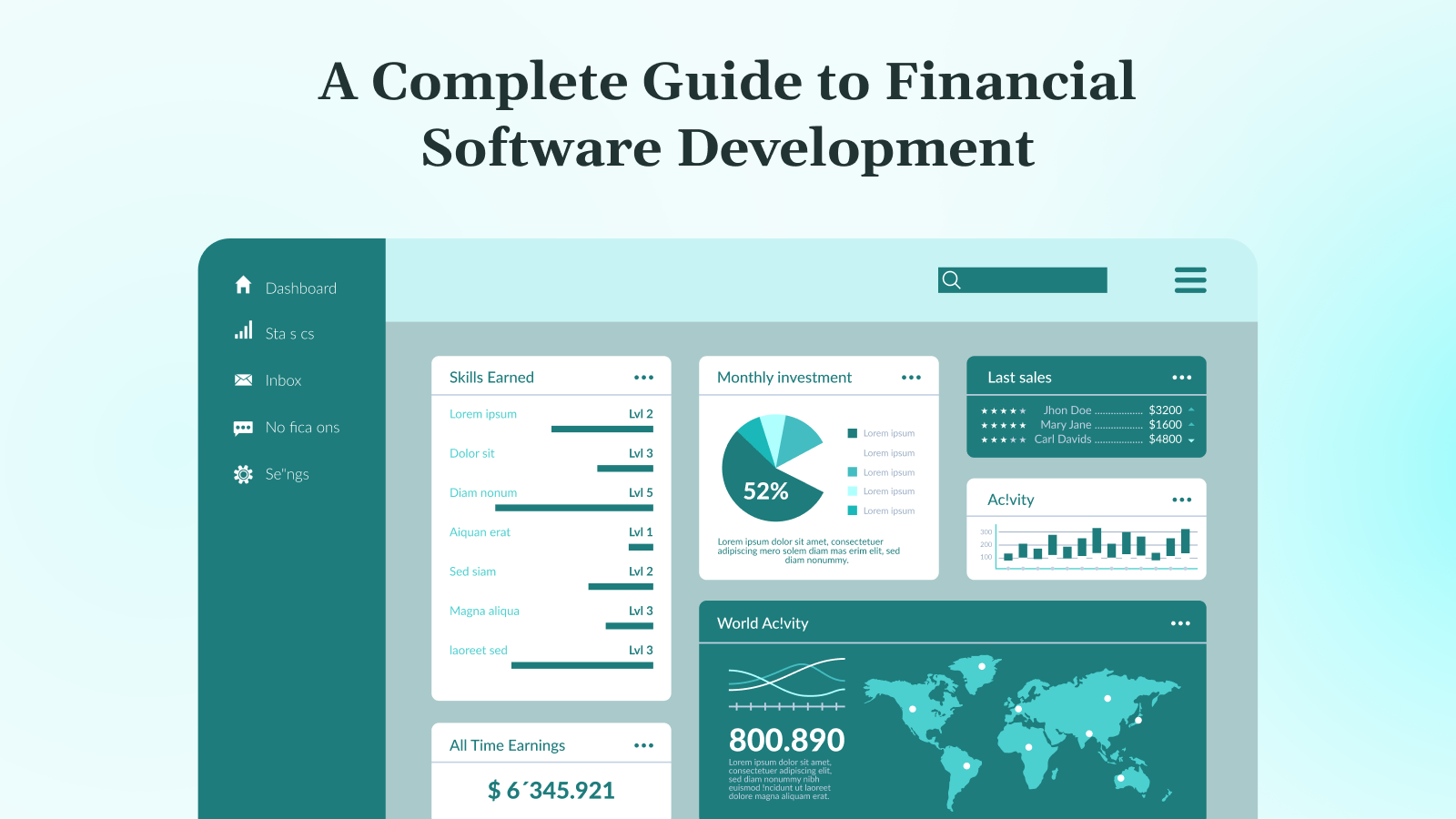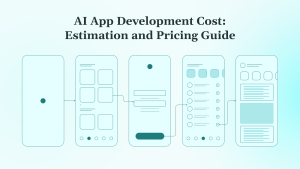Despite the $151 billion market for financial software in 2024, most organizations continue to struggle with getting it right. The pressure to modernize, stay compliant, and build user trust while competition accelerates is relentless.
Financial software development offers a direct path forward. With the right architecture, security, and compliance strategy, technical leaders can build products that scale quickly without incurring long-term risks or rework.
This guide explains how to approach financial software development with clarity and control. It covers system design, infrastructure, security protocols, compliance standards, and the role of technologies such as AI and blockchain in reshaping the finance industry.
Key Takeaways
- Financial software now powers core operations, compliance, scale, and customer trust; all depend on getting it right.
- Security, performance, and auditability must be designed into the system from the beginning.
- Technologies like AI, blockchain, and cloud infrastructure are reshaping finance, but only when applied to regulatory and architectural disciplines.
- Legacy modernization is possible without full rewrites by using APIs, modular architecture, and infrastructure automation.
- Success depends on teams that understand both financial logic and system architecture; execution matters as much as code.
What Is Financial Software Development?
Financial software development is about building secure, high-performance systems that power how money moves, gets tracked, and stays compliant. That includes everything from mobile banking apps to automated trading platforms, handling billions in transactions with zero tolerance for downtime or data loss.
It goes far beyond basic transaction handling. Modern financial systems connect with payment rails, fraud detection engines, regulatory bodies, and CRMs, all in real time across regions, currencies, and compliance boundaries. Every part of the stack must be accurate, auditable, and fast.
Importance in the Financial Sector
Financial software now serves as the backbone infrastructure for financial services. Banks process over 150 billion transactions annually through digital channels, while investment firms rely on automated systems for portfolio management and risk assessment. Insurance companies use software to evaluate claims, detect fraud, and manage policyholder data across decades-long relationships.
The shift from paper-based processes to digital-first operations has made software reliability directly tied to business continuity. When financial software fails, it can freeze business operations, trigger regulatory investigations, and result in significant financial losses.
Key Stakeholders
Financial software development brings together teams with different objectives, from ensuring compliance to delivering reliable user experiences. Balancing these priorities requires a process that supports both technical execution and strategic oversight.
Let’s look at some of the key stakeholders involved.
- Technical Teams: Responsible for system architecture, performance, and reliability. They build platforms that scale, handle complex financial logic, and integrate with third-party services; decisions here directly affect uptime and maintainability.
- Compliance Officers: Translate regulatory rules into system requirements and ensure every release meets legal standards like PCI DSS or SOX. Their work protects the business from fines and compliance failures.
- Product Managers: Define roadmaps, prioritize features, and align user needs with business goals. Their choices shape the product’s value, usability, and market success.
- Risk Management Teams: Identify vulnerabilities and design controls that strengthen resilience. They model threats, define risk thresholds, and ensure the system can withstand real-world stress.
- End Users: Expect fast, secure, and intuitive experiences. Their behavior and feedback shape adoption, retention, and future feature development.
- Auditors: Require full visibility into systems, logs, access controls, and documentation. Their reviews confirm compliance and flag operational gaps before regulators do.
Why Strategic Investment in Financial Software Is Critical in 2025
Compliance demands are intensifying mandates like the EU’s DORA, which demands that your systems meet strict technical standards, not someday, but now. If your architecture can not adapt, you risk falling behind, facing costly rewrites, or worse, regulatory fines and loss of trust.
Meanwhile, fintech startups are already delivering instant payments, one-click onboarding, and personalized insights at scale. That is what users expect. If you cannot match that speed and flexibility, you will be irrelevant.
Legacy systems are no longer holding up under modern workloads. Strategic investment is how financial institutions stay secure, scalable, and competitive; without it, you are one outage or delay away from losing market share. Addressing these challenges proactively is the only way to stay ahead without compromising delivery, compliance, or growth.
Now, if you are thinking of modernizing without breaking what is already working? We specialize in upgrading legacy financial systems securely, quietly, and with zero disruption. If compliance, scale, and long-term maintainability matter to you, get in touch with us.
What Types of Financial Software Do Teams Build?
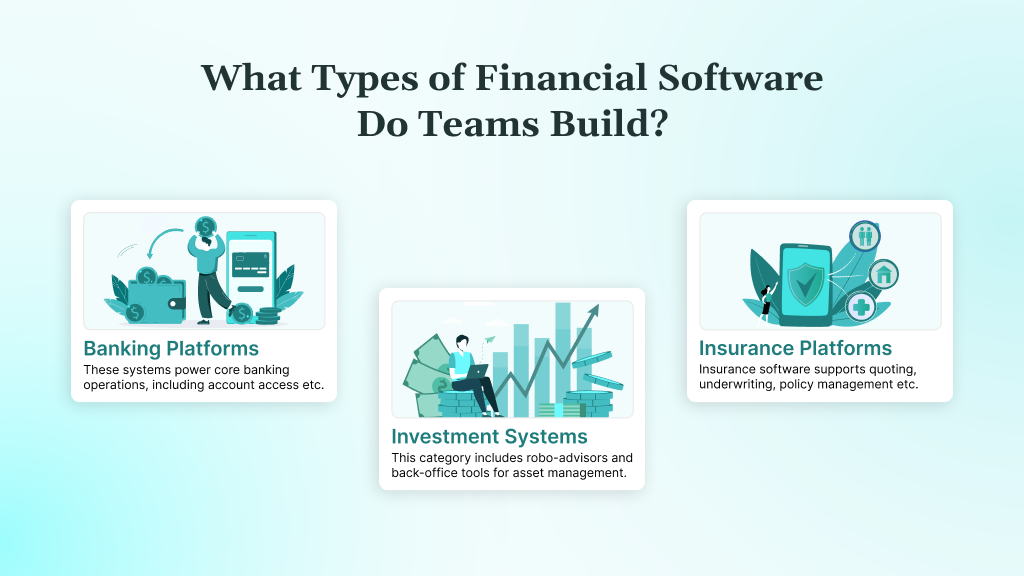
Financial software spans multiple product lines, each shaped by distinct operational goals, compliance requirements, and system behaviors. It is advisable to define the product scope early to make informed choices about architecture, data handling, and long-term maintainability.
Banking Platforms
These systems power core banking operations, including account access, digital onboarding, real-time settlements, and fraud controls. They must deliver consistent uptime, transactional accuracy, and compliance with regional and global standards. Many builds involve wrapping legacy cores with modern APIs or gradually replacing them with modular services.
Investment and Wealth Systems
This category includes robo-advisors, portfolio dashboards, and back-office tools for asset management. Teams work with live market data, performance tracking, and advisory logic under strict regulatory oversight. Builds must support accurate calculations, version-controlled updates, and responsive UI layers for investor confidence.
Insurance Technology Platforms
Insurance software supports quoting, underwriting, policy management, and claims workflows. High variability in scenarios and deep reliance on legacy systems require modular build patterns. Rule engines, data validation, and ML-assisted decision-making help automate high-volume operations while reducing the risks associated with manual handling.
Key Principles of Financial Software Development
Building in finance comes with the pressure that most systems never face. A delay, mismatch, or missed control can lead to real consequences, compliance exposure, reputational damage, or operational failure.
You have likely dealt with legacy constraints, shifting audit rules, and unclear handoffs between teams, all while being expected to ship clean. That is why these principles matter.
Compliance must be engineered from day one. Below are some of the principles that you should know before building financial software.
Security and Regulatory Alignment
Security affects how data flows, how services communicate, how access is granted, and how incidents are contained. If it is not in the architecture, it shows up later as downtime, audit flags, or production fire drills.
However, regulatory compliance requires an understanding of applicable frameworks and building controls into software architecture. You can use
- PCI DSS compliance for payment processing
- SOX requirements for financial reporting
If your architecture cannot support security and compliance by default, it will fail under scrutiny.
Scalable, High-Performance Design
Scalable architectures accommodate growth without requiring complete system rewrites. Microservices architecture allows independent scaling of different system components based on demand patterns. Database optimization includes proper indexing, query optimization, and data partitioning strategies.
Performance requirements vary significantly across different financial software functions. Real-time trading systems require microsecond response times, while batch processing systems prioritize throughput over latency. You should know these requirements early to guide appropriate technology selection and architecture decisions.
UX That Builds Confidence
User experience design for financial software must balance ease of use with security requirements. Progressive disclosure techniques present complex information in digestible formats. Clear error messages and status updates help users understand the system state and next steps.
Trust-building interface elements include:
- Security indicators
- Transaction confirmations
- Transparent fee disclosure
Mobile-first design approaches accommodate the growing preference for mobile financial services while maintaining security standards.
Data Accuracy and Consistency
Data integrity mechanisms prevent corruption and ensure consistency across distributed systems. Database transactions use ACID properties to maintain data consistency during concurrent operations. Data validation occurs at multiple layers, including input validation, business logic validation, and database constraints.
Real-time data sync across systems depends on tight coordination. Without it, transactions can be applied twice, balances fall out of sync, and approvals move forward on outdated data. Event-driven architecture helps maintain consistency by triggering updates only when specific actions occur, so systems stay aligned without locking each other down.
Modular Build Patterns
Modular architecture enables independent development, testing, and deployment of different system components. API-first design approaches ensure consistent integration patterns and allow flexible system composition. Containerized deployments enable consistent environments across development, testing, and production.
Configuration management separates environment-specific settings from application code. This approach enables consistent deployments across different environments while maintaining security and compliance requirements.
Principles are your starting point, but they only take you so far. The real challenge is building the system around them. Let us walk through how that happens.
The Financial Software Development Process
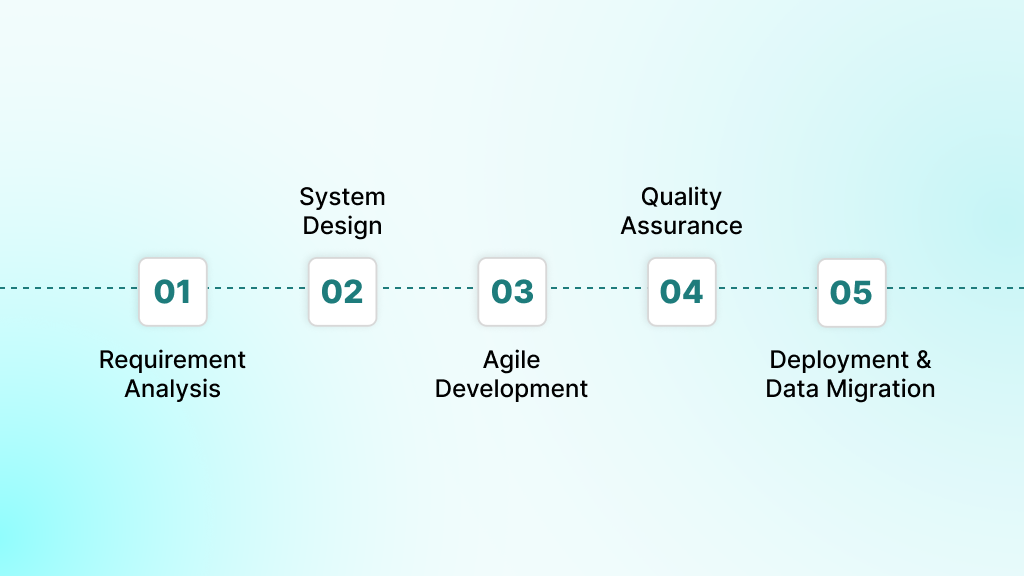
Financial software development follows a structured methodology that balances rapid delivery with rigorous quality control. This process must accommodate complex regulatory requirements while maintaining development velocity and system reliability. Each phase builds upon previous work while incorporating feedback loops that prevent costly late-stage discoveries.
Step 1: Discovery and Requirement Analysis
This is where clarity saves months of rework. Before you build anything, you need to understand what the system needs to support, including high-volume transactions, data retention policies, compliance triggers, and user access flows.
Stakeholder input is critical here, but so is filtering it. Not every request turns into a feature. This stage is about mapping real workflows, uncovering constraints, and translating regulatory obligations into system-level decisions.
Performance expectations, security controls, and integration points all surface here, and they should directly influence architecture. If this step is rushed, the build drifts fast.
Common tools used:
- Confluence for mapping decisions and traceability
- Jira for breaking requirements into trackable units
- Miro to visualize flows across teams
- Postman to validate early API dependencies and assumptions
Step 2: Architecture and System Design
Architecture shapes everything that comes next, from how fast you can ship to how confidently you can scale under pressure. Every core decision here has a downstream impact: latency, compliance alignment, failover behavior, and data integrity.
Cloud-native environments offer flexibility, but they come with limits around data sovereignty and region-specific regulations. Microservices bring autonomy, but they introduce complexity in synchronizing states, securing service-to-service calls, and maintaining consistency across transactions.
Your data layer needs the same discipline. Every table, index, and permission affects how you store financial records, generate reports, and meet audit expectations. Security design defines how identity, access, and encryption work across the stack.
Common tools used:
- Lucidchart / Draw.io for architecture flows
- AWS Well-Architected Tool to pressure-test decisions
- Terraform to provision repeatable, compliant infrastructure
Step 3: Agile Development and DevOps Implementation
Financial software requirements do not stay fixed; new edge cases, regulatory shifts, and integration demands show up mid-cycle. That makes flexibility essential. Agile helps teams respond quickly without losing structure or delivery focus.
Sprint cycles provide teams with the space to ship features while also addressing critical technical debt and security updates. These cycles create predictable checkpoints for stabilizing core services before they move downstream.
To maintain that pace without compromising quality, CI/CD pipelines must do more than automate builds. They validate each commit, catch issues early, and enforce standards at every stage of the process. Security tests, static analysis, and performance checks run continuously, not tacked on later when risk is higher.
DevOps practices keep the whole pipeline moving. Infrastructure as code ensures environments stay consistent and repeatable. Containerization simplifies deployments, isolates changes, and gives teams the confidence to release often without risking production.
Common tools used:
- GitLab for version control and integrated CI/CD
- Jenkins for custom automation flows
- Docker for containerized deployments
- SonarQube for ongoing code quality and security checks
Step 4: Multi-Layer Testing and Quality Assurance
Every financial workflow depends on accuracy, speed, and security. If your tests miss something, the fallout can hit revenue, trust, and compliance.
Each layer of testing plays a role. Unit tests verify core logic. Integration tests ensure that systems communicate with each other without disrupting the flow. Security tests examine the vulnerabilities in how access, input, and data handling are structured. Performance testing checks how the system behaves under real-world load.
All of this needs to happen early and often. Waiting until the end creates blind spots and delays. Strong testing maintains high product velocity without compromising stability.
Common tools used:
- Jest for unit and integration tests
- Selenium for UI flows
- OWASP ZAP for security scanning
- JMeter for load and stress testing
Step 5: Deployment, Data Migration, and Client Onboarding
Once the system has cleared testing, it is time to transition from staging to real-world use. However, this step is where uptime, data accuracy, and user experience intersect.
A reliable deployment process starts with risk control. Blue-green and canary strategies help release features gradually without affecting all users at once. These methods give teams room to observe system behavior, roll back instantly, and avoid late-night incident calls.
That control matters even more during data migration. Moving financial records from legacy systems or between environments introduces serious risk. Every mapping, timestamp, and conversion has to be verified. If migration fails, user trust and regulatory integrity are both at stake.
After rollout and migration, onboarding flows come into play. For banks, lenders, or investment platforms, this is where users meet the product. Onboarding has to be fast, secure, and compliant, with real-time ID verification, fraud detection, and risk scoring built in.
At the end of the deployment, the system proves itself under real conditions. Everything that follows depends on getting this part right.
Common tools used:
- Kubernetes for orchestrating production rollouts
- Ansible for automating consistent deployment tasks
- AWS RDS for handling safe, trackable data migration
- Datadog for watching system health before users spot issues
We know that building financial software that scales requires the involvement of experienced development teams who understand both technology and regulatory requirements. Our proven development process has delivered compliant and scalable solutions for organizations ranging from startups to enterprises. Schedule a consultation to discuss your project.
Technological Tools and Frameworks for Financial Software
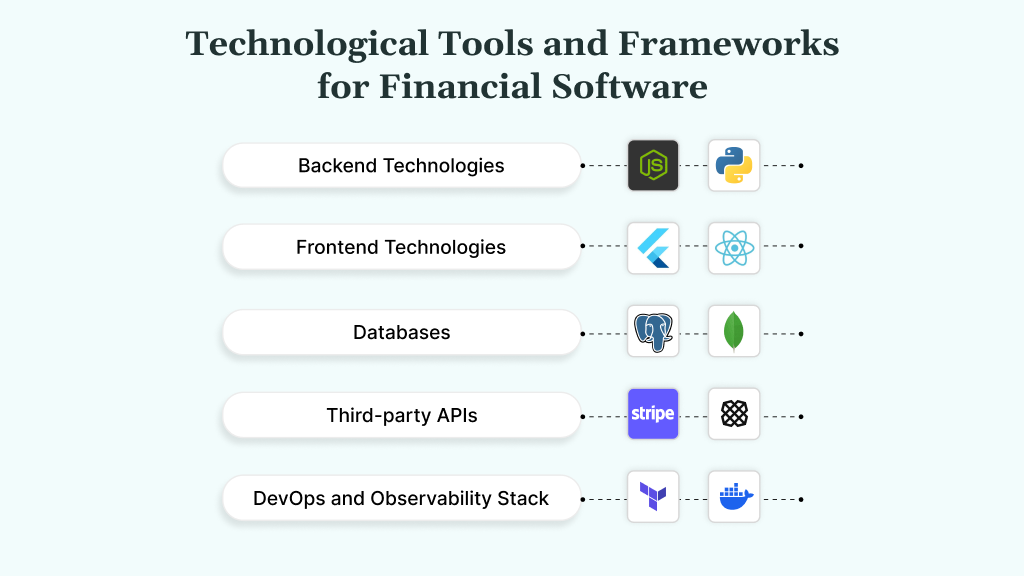
You have seen the full process, from idea to execution. But what holds it all together? The tools. Knowing the right ones puts you a step ahead in every phase of development.
Let us get to know them in detail:
Backend Languages and Runtime Environments
Your backend tech stack determines how well your system performs under pressure, especially when handling real-time trades and sensitive data. Here is how some of the most trusted languages stack up in real financial builds:
- Java: Still the go-to for enterprise finance systems. It is stable, battle-tested, and backed by frameworks like Spring Boot that speed up delivery without cutting corners. Strong typing and mature tooling help prevent the kind of calculation errors that can not be afforded in production.
- Go: Great for high-throughput systems, real-time trading, payment engines, and anything with concurrency demands. It is fast, memory-efficient, and compiles lean binaries that are easy to deploy and manage at scale.
- Python: Ideal for analytics-heavy workflows, risk models, forecasting engines, and compliance reporting. Libraries like Pandas and NumPy make it the default for financial data science. It is also quick to prototype, which helps when you are validating new ideas under pressure.
- Node.js: Works well for I/O-Intensive apps, such as API gateways, dashboards, or microservices, that process a large number of concurrent requests. Additionally, using JavaScript on both the front end and back end reduces context switching for development teams and speeds up delivery.
Frontend Frameworks for Financial Interfaces
Financial needs to surface live data, handle complex flows, and stay responsive under load. The frontend stack you choose affects not only UX but also how fast your team can ship and scale the product.
- React: Reliable and flexible for everything from dashboards to trading views. Its component-based model fits well with reusable, data-heavy interfaces. Add in libraries like Recharts or Victory, and you have the foundation for real-time charts and portfolio views that do not choke under load.
- Angular: This is best when you are building large, structured platforms with heavy logic on the front end, like insurance portals or admin consoles. TypeScript support and built-in tooling give you more control, and the framework’s opinionated setup keeps things consistent across teams.
- Vue.js: Lightweight but scalable. Easy to slot into legacy systems or prototypes, and still strong enough for full-scale applications. Its simplicity cuts down on ramp-up time, while Vuex and other state management tools help maintain UI stability in complex workflows.
Databases Optimized for Financial Loads
Financial systems move money, track history, and produce reports that auditors and regulators rely on. That means your database must handle high-volume transactions, ensure consistency, and still serve analytics without crashing.
- PostgreSQL: A relational database known for strong ACID compliance and reliability. It is ideal for core transaction processing, where integrity, accuracy, and auditability come first. Features like JSON support and custom data types enable you to model financial products without sacrificing structure.
- Redis: An in-memory data store built for speed. Use it as a caching layer to serve real-time balances, session tokens, or fraud-scoring results in microseconds. Its pub/sub features also make it useful for pushing live updates across distributed systems.
- Apache Cassandra: A distributed NoSQL database designed for high availability and massive scale. Best used for global financial platforms that can not afford downtime. While it sacrifices strict consistency for uptime, it is ideal for use cases such as logging, transaction metadata, or fraud event streams.
Third-party APIs and Financial Data Services
The right APIs let you plug into verified data sources, streamline onboarding, and launch features faster without compromising compliance. Below are some related tools to use:
- Plaid: An API service that connects apps to user bank accounts across thousands of institutions. Use it to handle account linking, balance checks, and transaction categorization without storing sensitive credentials yourself. Real-time webhooks enable you to trigger fraud checks or insights instantly.
- Stripe: A payment infrastructure platform with developer-first APIs. It handles everything from card payments and bank transfers to KYC, compliance, and fraud detection. Ideal for teams that need global payment coverage without building an entire billing engine in-house.
- Open Banking APIs: Standardized interfaces that let you access customer-permissioned data from banks and financial institutions. Use them to power budgeting apps, loan eligibility engines, or account aggregation tools while staying aligned with regulatory protocols like PSD2 and RBI guidelines.
DevOps and Observability Stack
DevOps tools enable the reliable deployment and monitoring of financial software systems. These tools provide the automation and visibility needed to maintain high availability and performance.
- Docker: A containerization tool that packages code and dependencies into isolated units. It ensures consistency across development, testing, and production environments, eliminating the “works on my machine” problems and enabling faster, safer rollouts.
- Kubernetes: An orchestration system that manages containers across clusters. It automates deployment, scaling, and recovery. Financial systems maintain high uptime while handling workload spikes and enforcing network security policies.
- Prometheus & Grafana: Prometheus collects real-time metrics, and Grafana turns them into actionable dashboards. Together, they help teams track everything from infrastructure health to transaction volumes so you spot issues before users do.
- Terraform: A tool for defining infrastructure as code. It consistently creates, updates, and tears down cloud environments. For regulated systems, it also provides a version history and audit trails every time a change occurs.
Even with the right technology foundation, financial software development presents unique challenges that require specialized expertise and proven solutions. These challenges span regulatory compliance, security requirements, and technical complexity that traditional software development does not encounter.
Challenges in Financial Software Development
Even with the right tools and architecture, financial systems still face challenges that many software systems never encounter. These challenges are specific, technical, and often regulatory; solving them requires more than clean code or fast delivery. We have compiled a list of challenges that might surprise you during the building process, along with some insider tips on how to tackle them.
1. Adapting to Constantly Changing Regulations
Compliance is a moving target. Requirements vary by region, shift quickly, and may sometimes be applied retroactively.
Why is it a challenge?
- Jurisdictions impose unique rules with short lead times.
- Legacy systems are hard to adapt under pressure.
- Compliance logic tied to core code slows response.
How to handle it:
- Isolate regulatory logic as a separate module or service.
- Use configuration-driven rule engines for faster updates.
- Embed audit trails directly into workflows.
2. Protecting Sensitive Financial Data
Data breaches in finance carry financial, legal, and operational consequences that extend far beyond downtime.
Why is it a challenge?
- Attack surfaces are large and constantly evolving.
- Insider threats and over-permissioned roles often go unnoticed.
- Storage location laws restrict cloud and infrastructure choices.
How to handle it:
- Adopt zero-trust access control from the start.
- Encrypt data across its full lifecycle
- Monitor user behavior and log all access activity.
3. Innovating While Staying Audit-Ready
Fast iteration must still meet strict oversight. Auditors require transparency at every level, particularly in systems driven by AI or automated logic.
Why is it a challenge?
- Machine learning models must provide explainable outputs.
- Every system change requires traceability.
- CI/CD pipelines risk introducing non-compliant changes.
How to handle it:
- Automate compliance checks into your build and deploy stages.
- Store model versions, parameters, and outputs for every update
- Log decision points clearly and consistently.
4. Untangling Legacy Systems
Older systems still run critical operations, but they were not built for today’s integration or scalability demands.
Why is it a challenge?
- Business logic is deeply embedded and poorly documented.
- Rewrites are costly and high-risk.
- Integration points can not handle modern loads.
How to handle it:
- Use APIs to wrap legacy systems instead of replacing them outright.
- Introduce microservices gradually for new features.
- Sync and monitor data across old and new systems with rollback paths.
5. Scaling Without Downtime or Compromise
Financial platforms must scale seamlessly without compromising compliance, data integrity, or user trust.
Why is it a challenge?
- Even short outages can trigger legal or financial consequences.
- Latency impacts transaction integrity and user confidence.
- Failure at one point can cascade across services.
How to handle it:
- Use active-active setups and automated failover.
- Load balance across zones with health checks in place
- Automate backups, replication, and disaster recovery tests
Trends and Innovations
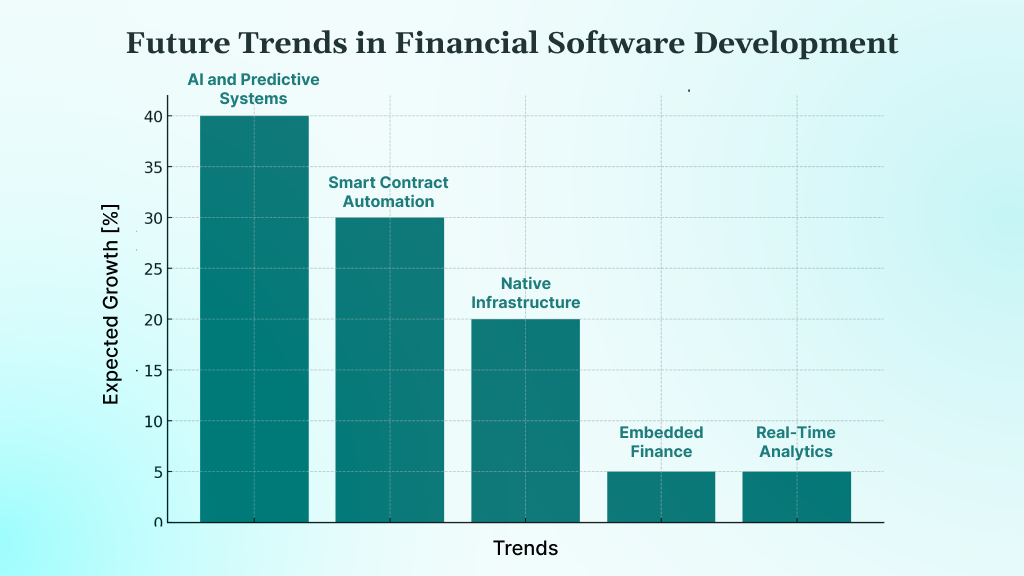
Financial technology continues evolving rapidly, driven by advances in artificial intelligence, blockchain technology, and cloud computing. These innovations create new opportunities for financial service delivery while presenting implementation challenges that require careful planning and execution.
AI and Predictive Systems
AI models now drive fraud detection, credit scoring, and personalized financial experiences at scale. Real-time data processing and machine learning have replaced manual reviews in high-stakes decisions.
- Example: JPMorgan’s AI systems process billions of signals daily to cut fraud and automate document review, freeing up both time and capital.
Blockchain and Smart Contract Automation
Distributed ledgers bring transparency and eliminate the need for intermediaries. Use cases span everything from tokenized assets to automated loan agreements.
- Example: Ant Group’s blockchain handles over 100 million daily transactions across cross-border payments and supply chain finance, cutting costs and boosting speed.
Cloud-Native Infrastructure
Serverless and container-based architectures support elastic scaling, lower costs, and faster releases, all while meeting strict uptime and compliance standards.
- Example: Capital One runs entirely on AWS, scaling with demand and reducing infrastructure costs by 40%.
API-First and Embedded Finance
Open banking and BaaS platforms let fintechs and non-financial players offer regulated financial services through plug-and-play APIs.
- Example: Plaid connects 11,000+ banks to fintech apps, powering billions of secure API calls for apps like Robinhood and Chime.
Real-Time Analytics and Event-Driven Systems
Event-based systems allow financial platforms to react instantly to transactions, risks, or user behavior at scale.
- Example: Goldman Sachs processes over 50 billion market signals per day to power algorithmic trades and live risk monitoring.
Your success depends on translating innovation into practical solutions that meet both technical requirements and business objectives.
Conclusion
Building financial software means engineering for precision, scale, and compliance from day one. It is not just a technical challenge. It is a product, security, and regulatory challenge combined.
The companies that get it right are those that align product scope with system behavior, build for audit readiness, and choose architectures that scale without requiring rework.
DEVtrust helps financial teams do exactly that. Our engineers possess in-depth domain knowledge and hands-on experience across banking, wealth management, and insurance platforms. Every system we deliver is built to perform, scale, and withstand regulatory scrutiny.
Contact us today to discuss how we can accelerate your financial software development.
A Complete Guide to Financial Software Development
Master financial software development! Learn key principles, tackle challenges, and explore best practices for secure, innovative solutions. Dive in now!
Contact Us